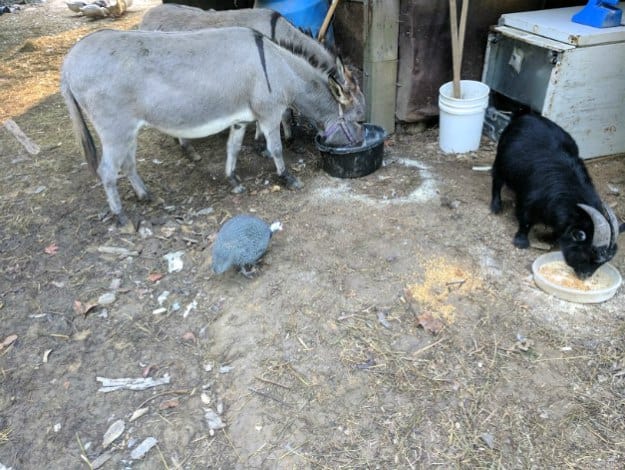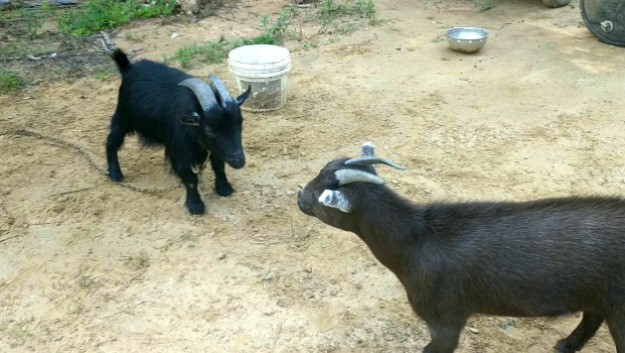Goats on the homestead may be the perfect livestock regardless of the size of the parcel you own or are leasing to create a sustainable farm. If living in a “right to farm” state, you may even be able to keep a pygmy or dwarf goat in a suburban backyard.
Goats On The Homestead: The Perfect Livestock For Your Farm
Even though Nigerian dwarf goat and pygmy goats are small in size, they are still enormous weed eaters. Any chore you can take off the daily “to do” list on the homestead is a time, energy, and money saver! Whether you decide to pen or free-range you goats, pygmy and dwarfs should be easier to keep contained than their standard-size peers because they cannot jump as high and would have to be able to climb up and out of their enclosure.

Both breeds are known to be so docile they are rarely ever de-budded (horn removed) when place in petting zoos. Children of lower elementary school age often keep goats for their 4-H projects. Teaching children homesteading skills should begin at a young age, another reason small stature goats can be of value on the sustainable farm.
- Stylish show halter blends well with the color of the goat
- Solid chain lead with snap allows for quick and easy...
At least 4-H programs now allow several classes other than market for goats – meaning the animals do not have to be slaughtered and are returned to their youthful owners. In some areas “Kids Raising Kids” allow for an early introduction to learning goat care through 4-H programs. Specialized partnership projects between older 4-H and FFA members with children with disabilities also now exist and permit goats as project animals.
More than 200 different breeds of goats are currently in existence. Although some are bred solely for meat or milk production due to their natural attributes for either, female goats from all breeds can be milked and meat can be harvested from each breed as well.
Goat milk is far sweeter than cow's milk and is often regarded as being more acceptable to folks who suffer from lactose intolerance problems.
Nigerian Dwarf Goats
These small dairy goats on the homestead are capable of producing up to one-half gallon of deliciously sweet milk in a single day. You won't be able to get as much milk from a dwarf as is possible with a standard-size goat, but the investment in a dwarf goat both from a purchase and maintenance standpoint.
Both Nigerian dwarf goats and pygmy goats originated in Africa and can live for up to 15 years, on average. They also typically weigh between 50 and 100 pounds once they reach maturity around two years old. Wethers, or castrated male goats, and billy goats – intact males tend to weigh slightly more than doelings (young female) or nanny goats – mature female.
No products found.
Pygmy Goats
This breed of meat goat is often praised for its docile personality and sturdy body that basically resembles a barrel. The small stature meat goats will not produce as much protein as a standard-size goat, but again, the space a pygmy goat will require to roam, be housed, and the amount of feed required during the winter are substantially less than larger goats. Basically, you get a good bang for your buck while raising your beef and dairy products.
Pygmy goats can earn their keep in weed-eating and breeding sale even if you never plan to butcher the cute little things. The price for Nigerian dwarf and goats and pygmy goats varies depending upon location and time of year, but they each typically sell for between $85 and $125 each. Goats on the homestead usually give birth to a single kid in their first litter, but in all subsequent litters twins (sometimes triplets) are typically born. They are known to be a very fertile breed.
Free-Ranging Goats

The small goats on the homestead require significant less housing and grazing space – and cost a whole lot less to winter over than standard-size goats. Many a farmer over the centuries has lamented over goat housing woes. The medium-sized livestock is notoriously difficult to keep inside a fence…any fence.
In a concerted effort to maximize the benefits of having goats on our large homestead and to curtail the common frustrations so often associated with keeping goats, I decided to free-range our herd. Fellow homesteading and rural friends that have also raised goats thought I was completely nuts – at first.

Shockingly, the process of teaching goats to free range went both quickly and quite easily. I started with just one goat, a 3-year-old female. We kept her on a long chain for just two days to allow her to get acclimated to her new home, before putting her on a lead strap and going for walks to learn her territory.
Pearl, a pygmy goat, bonded with my female blue heeler almost immediately – another thing seasoned goat keepers said would never happen. On day three I let Pearl off the lead strap and allowed her to roam about supervised, with Jovie.
The goat and dog played and romped and ran along behind me during 4-wheeler rides. Although Pearl still has not become taken with Jovie's brother, Ruger, the dogs and the free-range herd of goats get along just fine.
Initially, the horses and mini donkeys did not know what to make of Pearl and refused to intermingle in the barn – but that too soon subsided after the massive horses realized the tiny goat was not a threat.
Even though I care for the most bull-headed mare on the planet, no kicking, biting, or any other bad behavior ever occurred between her herd and the pygmy goat.
Once the first goat was comfortably free-ranging, we purchased her a mate and embarked upon the process all over again. The second time was even simpler.
“Not Negan,” a dwarf billy goat, was only kept on a chain for 24 hours – it was abundantly clear Pearl was in charge and he was going to follow her everywhere and never leave her side. Be prepared for the pungent “Billy Goat Musk” smell, apparently, the mating prowess scent emitted by billy goats is not at all diminished due to size!
- Stainless Steel blades
- Wooden handles
Goat Care Tips
- Goats are ruminant livestock – like cows. Contrary to common belief, cows do not have four stomachs but four chambers in their stomach – like goats, sheep, deer, and elk – among a handful of other animals but wild and domestic. The ruminant is one of the stomach chambers and when it gets out of whack, bloat occurs and must be treated quickly or a painful death could result. Drenching small goats with a 1 to 1 ratio of a mineral oil and baking soda – with a few drops of peppermint essential oil thrown in should break up the thick gas bubble rather quickly. Standing the goat up on its hind legs and gently rubbing the sides of its stomach should help produce the needed belching or flatulence.
- Dwarf and pygmy goats should eat up to 2 and a half pounds of hay or forage materials per day to get the nutrients they need and keep their stomach balance in check.
- Goats should be wormed about four times per year.
- Goat hooves must be trimmed regularly to prevent a painful and potentially debilitating deformation and rot from occurring. A farrier can perform the service for a nominal fee or you could quite easily learn how to properly trim and buy the needed file from a local agricultural supply store for around $25.
- Goat fencing could be comprised of upturned pallets with either barbed-wire or high-tensile wire woven in between the slats – or just the wire firmly mounted to T-posts. Electric fencing is another option but is not always durable enough to deter a goat from running through it or hooking it with horns to pull it down.
Living Traditions Homestead shows a video of the best dairy goats for homesteading:
What do you think about having goats on the homestead? Let us know in the comments section below.
- Kills The 3 Major Gastrointestinal Parasites Most Frequently...
- Convenient monthly top dress

I’ve had goats most of my life. I love them. They are a PAIN in the butt at times! I’ve almost always had “full sized, dairy stock” goats – for milking and for brush eating. A couple times thru the years, I’ve had the “smaller” goats that you talk of in this article. I find them just as hard, (if not harder) to KEEP IN as the bigger goats. A friend of mine had the Fainting Goats for several years. As I understand it, they can not jump, so would not be as hard to keep in? Something to think about.
I want to buy a cream separator but have no idea which ones are best. Would like mid price range and need electric. Do you have any suggestions